MN2705 - Human Resource Management: Objectives and Variations
VerifiedAdded on 2023/06/15
|7
|1577
|133
Essay
AI Summary
This essay delves into the core objectives of Human Resource Management (HRM), emphasizing its role in modern organizations as a vital asset. It explores key objectives such as defining organizational structure, driving productivity, building employee coordination, ensuring job satisfaction, and adhering to ethical and legal standards. The essay also discusses the evolution of HRM practices, contrasting traditional approaches with more strategic methods, including vertical and horizontal integration. It further examines different HRM approaches like soft HRM (flexibility and commitment) and hard HRM (cost reduction). The analysis extends to the concept of employment relations and the wage-work bargain. The essay highlights the reasons for variations in HR practices across organizations, using examples like Simply Business (best practice) and Tesco PLC (best fit). Ultimately, the essay concludes that effective HRM is crucial for achieving organizational goals, maintaining competitiveness, and retaining talented employees, with varied practices reflecting diverse organizational cultures, objectives, and business models. Desklib offers a range of similar resources for students.
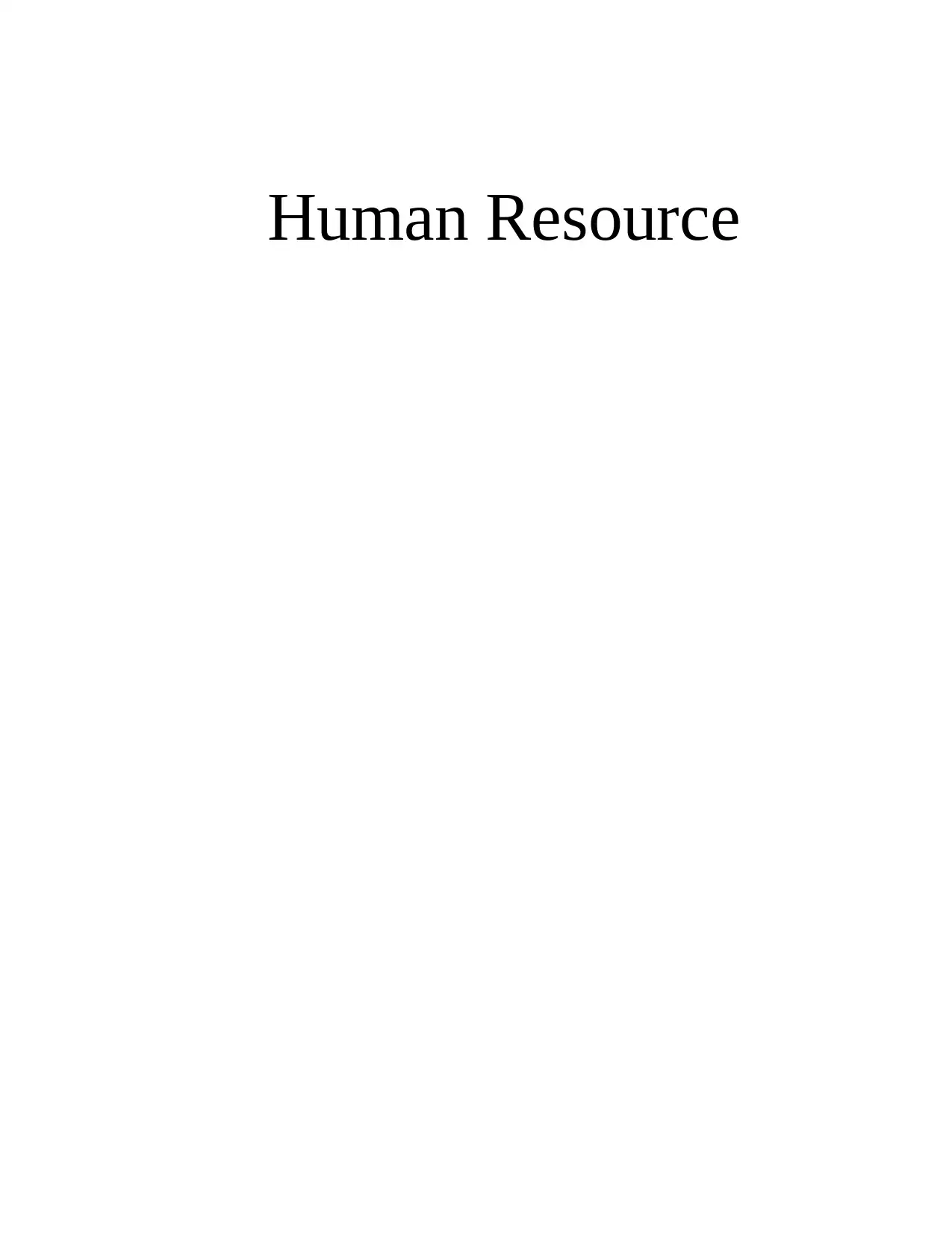
Human Resource
Paraphrase This Document
Need a fresh take? Get an instant paraphrase of this document with our AI Paraphraser
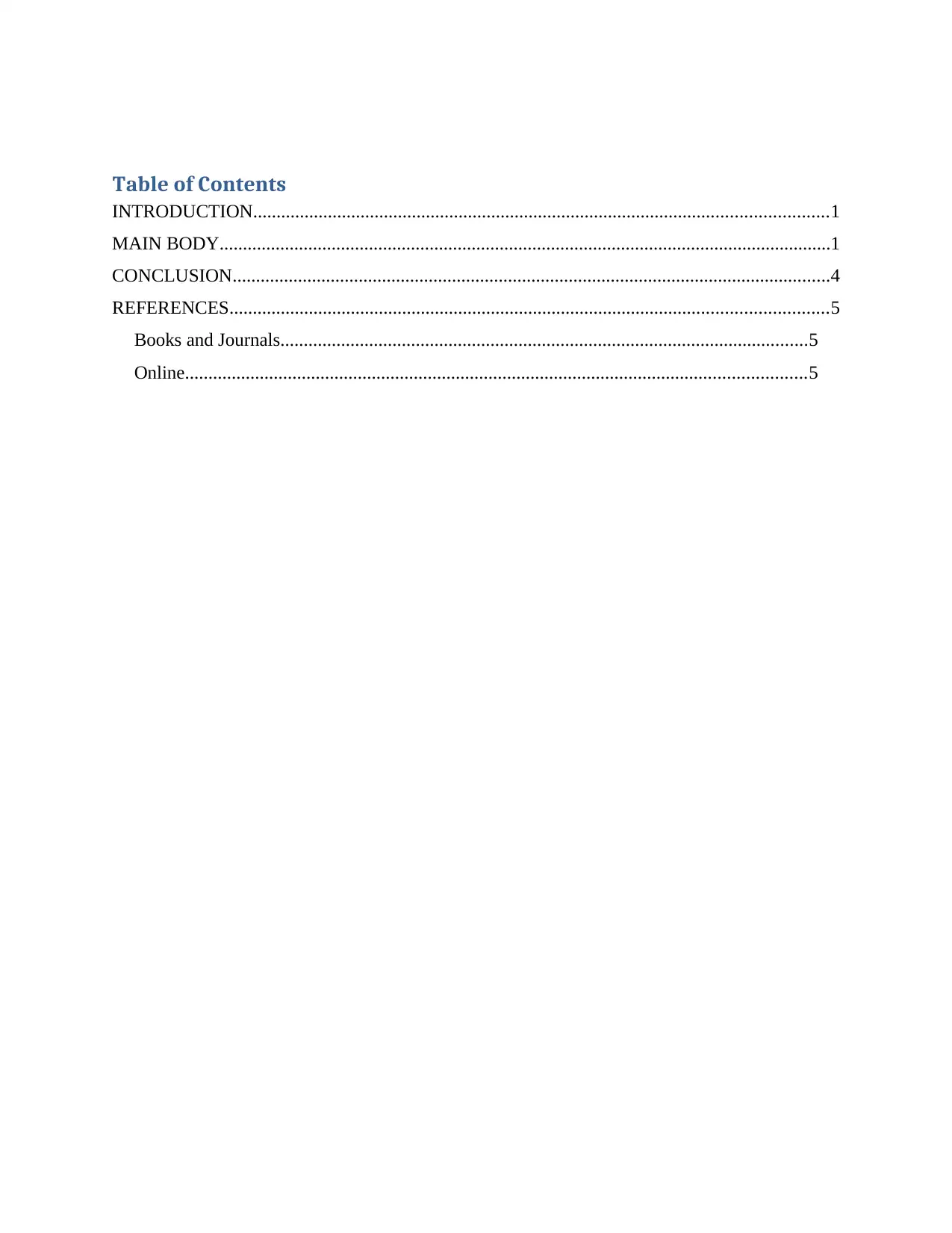
Table of Contents
INTRODUCTION...........................................................................................................................1
MAIN BODY...................................................................................................................................1
CONCLUSION................................................................................................................................4
REFERENCES................................................................................................................................5
Books and Journals.................................................................................................................5
Online.....................................................................................................................................5
INTRODUCTION...........................................................................................................................1
MAIN BODY...................................................................................................................................1
CONCLUSION................................................................................................................................4
REFERENCES................................................................................................................................5
Books and Journals.................................................................................................................5
Online.....................................................................................................................................5
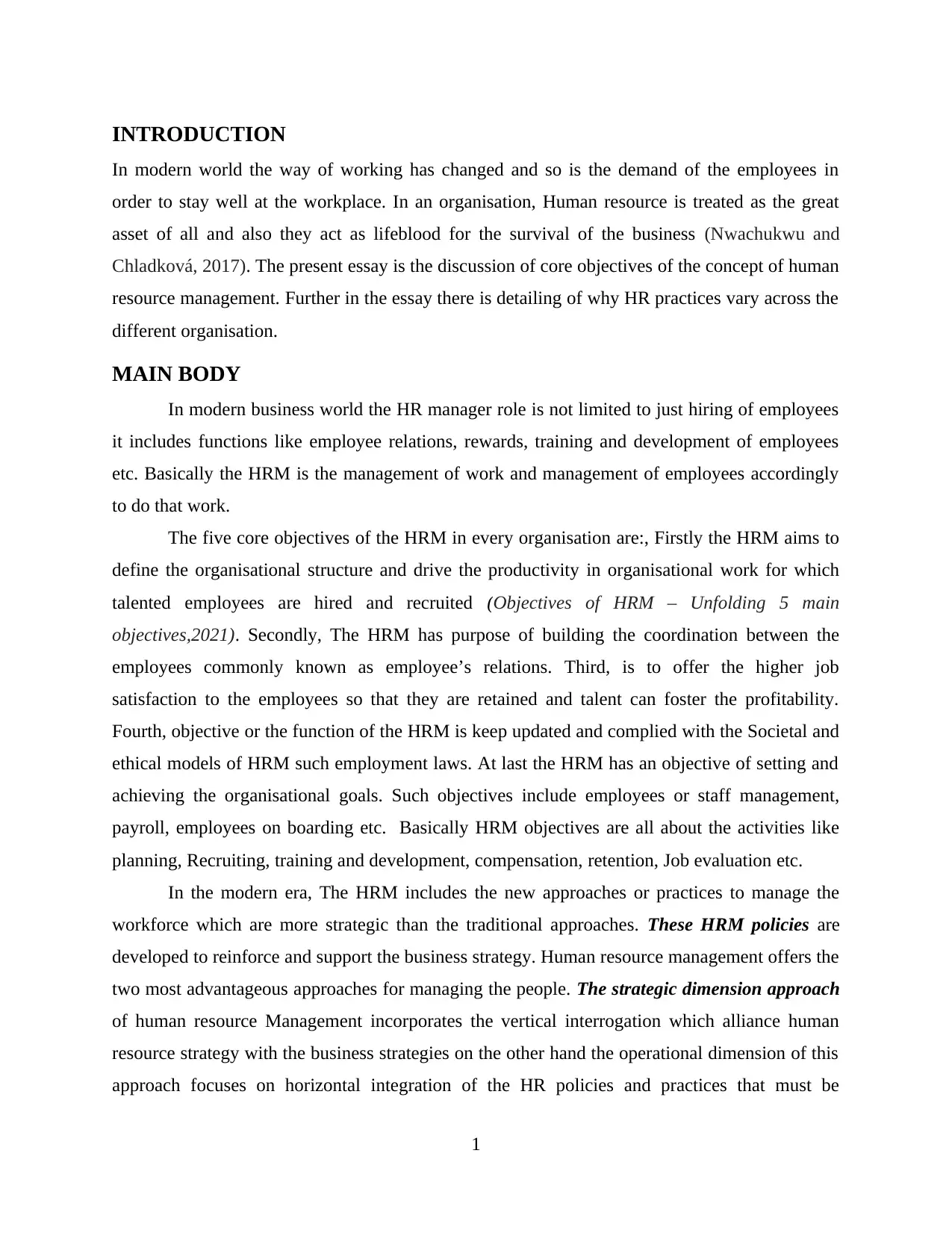
INTRODUCTION
In modern world the way of working has changed and so is the demand of the employees in
order to stay well at the workplace. In an organisation, Human resource is treated as the great
asset of all and also they act as lifeblood for the survival of the business (Nwachukwu and
Chladková, 2017). The present essay is the discussion of core objectives of the concept of human
resource management. Further in the essay there is detailing of why HR practices vary across the
different organisation.
MAIN BODY
In modern business world the HR manager role is not limited to just hiring of employees
it includes functions like employee relations, rewards, training and development of employees
etc. Basically the HRM is the management of work and management of employees accordingly
to do that work.
The five core objectives of the HRM in every organisation are:, Firstly the HRM aims to
define the organisational structure and drive the productivity in organisational work for which
talented employees are hired and recruited (Objectives of HRM – Unfolding 5 main
objectives,2021). Secondly, The HRM has purpose of building the coordination between the
employees commonly known as employee’s relations. Third, is to offer the higher job
satisfaction to the employees so that they are retained and talent can foster the profitability.
Fourth, objective or the function of the HRM is keep updated and complied with the Societal and
ethical models of HRM such employment laws. At last the HRM has an objective of setting and
achieving the organisational goals. Such objectives include employees or staff management,
payroll, employees on boarding etc. Basically HRM objectives are all about the activities like
planning, Recruiting, training and development, compensation, retention, Job evaluation etc.
In the modern era, The HRM includes the new approaches or practices to manage the
workforce which are more strategic than the traditional approaches. These HRM policies are
developed to reinforce and support the business strategy. Human resource management offers the
two most advantageous approaches for managing the people. The strategic dimension approach
of human resource Management incorporates the vertical interrogation which alliance human
resource strategy with the business strategies on the other hand the operational dimension of this
approach focuses on horizontal integration of the HR policies and practices that must be
1
In modern world the way of working has changed and so is the demand of the employees in
order to stay well at the workplace. In an organisation, Human resource is treated as the great
asset of all and also they act as lifeblood for the survival of the business (Nwachukwu and
Chladková, 2017). The present essay is the discussion of core objectives of the concept of human
resource management. Further in the essay there is detailing of why HR practices vary across the
different organisation.
MAIN BODY
In modern business world the HR manager role is not limited to just hiring of employees
it includes functions like employee relations, rewards, training and development of employees
etc. Basically the HRM is the management of work and management of employees accordingly
to do that work.
The five core objectives of the HRM in every organisation are:, Firstly the HRM aims to
define the organisational structure and drive the productivity in organisational work for which
talented employees are hired and recruited (Objectives of HRM – Unfolding 5 main
objectives,2021). Secondly, The HRM has purpose of building the coordination between the
employees commonly known as employee’s relations. Third, is to offer the higher job
satisfaction to the employees so that they are retained and talent can foster the profitability.
Fourth, objective or the function of the HRM is keep updated and complied with the Societal and
ethical models of HRM such employment laws. At last the HRM has an objective of setting and
achieving the organisational goals. Such objectives include employees or staff management,
payroll, employees on boarding etc. Basically HRM objectives are all about the activities like
planning, Recruiting, training and development, compensation, retention, Job evaluation etc.
In the modern era, The HRM includes the new approaches or practices to manage the
workforce which are more strategic than the traditional approaches. These HRM policies are
developed to reinforce and support the business strategy. Human resource management offers the
two most advantageous approaches for managing the people. The strategic dimension approach
of human resource Management incorporates the vertical interrogation which alliance human
resource strategy with the business strategies on the other hand the operational dimension of this
approach focuses on horizontal integration of the HR policies and practices that must be
1
⊘ This is a preview!⊘
Do you want full access?
Subscribe today to unlock all pages.

Trusted by 1+ million students worldwide
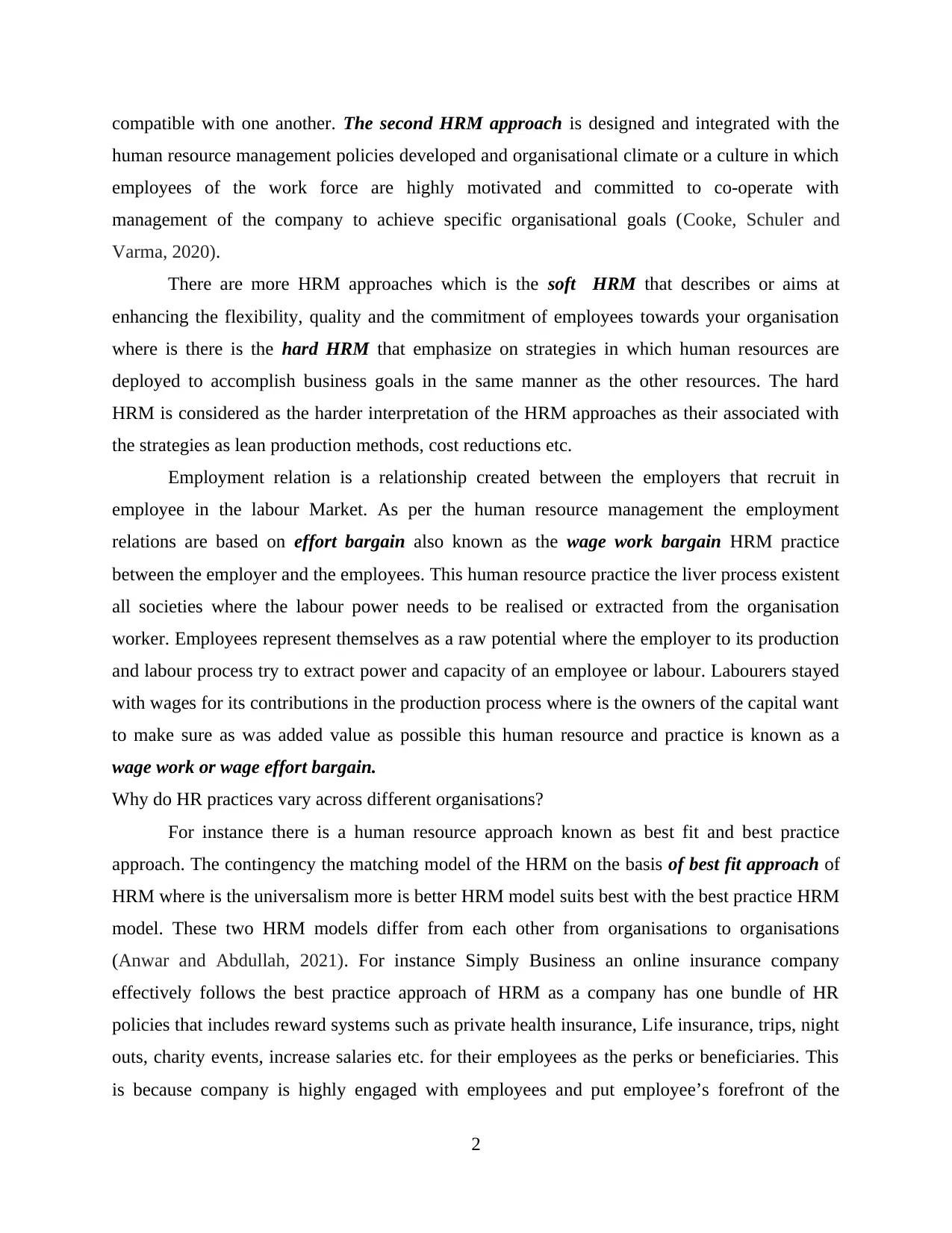
compatible with one another. The second HRM approach is designed and integrated with the
human resource management policies developed and organisational climate or a culture in which
employees of the work force are highly motivated and committed to co-operate with
management of the company to achieve specific organisational goals (Cooke, Schuler and
Varma, 2020).
There are more HRM approaches which is the soft HRM that describes or aims at
enhancing the flexibility, quality and the commitment of employees towards your organisation
where is there is the hard HRM that emphasize on strategies in which human resources are
deployed to accomplish business goals in the same manner as the other resources. The hard
HRM is considered as the harder interpretation of the HRM approaches as their associated with
the strategies as lean production methods, cost reductions etc.
Employment relation is a relationship created between the employers that recruit in
employee in the labour Market. As per the human resource management the employment
relations are based on effort bargain also known as the wage work bargain HRM practice
between the employer and the employees. This human resource practice the liver process existent
all societies where the labour power needs to be realised or extracted from the organisation
worker. Employees represent themselves as a raw potential where the employer to its production
and labour process try to extract power and capacity of an employee or labour. Labourers stayed
with wages for its contributions in the production process where is the owners of the capital want
to make sure as was added value as possible this human resource and practice is known as a
wage work or wage effort bargain.
Why do HR practices vary across different organisations?
For instance there is a human resource approach known as best fit and best practice
approach. The contingency the matching model of the HRM on the basis of best fit approach of
HRM where is the universalism more is better HRM model suits best with the best practice HRM
model. These two HRM models differ from each other from organisations to organisations
(Anwar and Abdullah, 2021). For instance Simply Business an online insurance company
effectively follows the best practice approach of HRM as a company has one bundle of HR
policies that includes reward systems such as private health insurance, Life insurance, trips, night
outs, charity events, increase salaries etc. for their employees as the perks or beneficiaries. This
is because company is highly engaged with employees and put employee’s forefront of the
2
human resource management policies developed and organisational climate or a culture in which
employees of the work force are highly motivated and committed to co-operate with
management of the company to achieve specific organisational goals (Cooke, Schuler and
Varma, 2020).
There are more HRM approaches which is the soft HRM that describes or aims at
enhancing the flexibility, quality and the commitment of employees towards your organisation
where is there is the hard HRM that emphasize on strategies in which human resources are
deployed to accomplish business goals in the same manner as the other resources. The hard
HRM is considered as the harder interpretation of the HRM approaches as their associated with
the strategies as lean production methods, cost reductions etc.
Employment relation is a relationship created between the employers that recruit in
employee in the labour Market. As per the human resource management the employment
relations are based on effort bargain also known as the wage work bargain HRM practice
between the employer and the employees. This human resource practice the liver process existent
all societies where the labour power needs to be realised or extracted from the organisation
worker. Employees represent themselves as a raw potential where the employer to its production
and labour process try to extract power and capacity of an employee or labour. Labourers stayed
with wages for its contributions in the production process where is the owners of the capital want
to make sure as was added value as possible this human resource and practice is known as a
wage work or wage effort bargain.
Why do HR practices vary across different organisations?
For instance there is a human resource approach known as best fit and best practice
approach. The contingency the matching model of the HRM on the basis of best fit approach of
HRM where is the universalism more is better HRM model suits best with the best practice HRM
model. These two HRM models differ from each other from organisations to organisations
(Anwar and Abdullah, 2021). For instance Simply Business an online insurance company
effectively follows the best practice approach of HRM as a company has one bundle of HR
policies that includes reward systems such as private health insurance, Life insurance, trips, night
outs, charity events, increase salaries etc. for their employees as the perks or beneficiaries. This
is because company is highly engaged with employees and put employee’s forefront of the
2
Paraphrase This Document
Need a fresh take? Get an instant paraphrase of this document with our AI Paraphraser
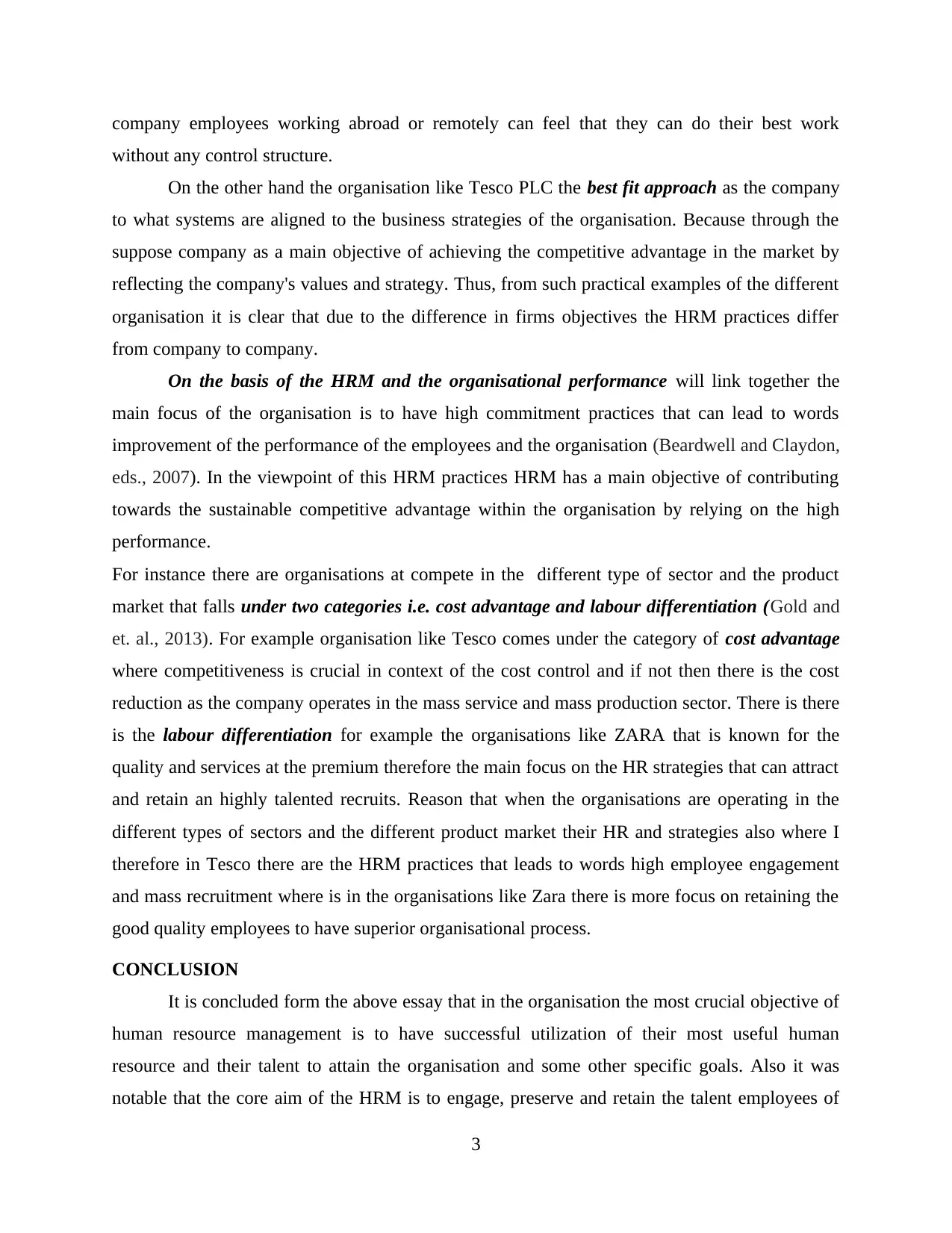
company employees working abroad or remotely can feel that they can do their best work
without any control structure.
On the other hand the organisation like Tesco PLC the best fit approach as the company
to what systems are aligned to the business strategies of the organisation. Because through the
suppose company as a main objective of achieving the competitive advantage in the market by
reflecting the company's values and strategy. Thus, from such practical examples of the different
organisation it is clear that due to the difference in firms objectives the HRM practices differ
from company to company.
On the basis of the HRM and the organisational performance will link together the
main focus of the organisation is to have high commitment practices that can lead to words
improvement of the performance of the employees and the organisation (Beardwell and Claydon,
eds., 2007). In the viewpoint of this HRM practices HRM has a main objective of contributing
towards the sustainable competitive advantage within the organisation by relying on the high
performance.
For instance there are organisations at compete in the different type of sector and the product
market that falls under two categories i.e. cost advantage and labour differentiation (Gold and
et. al., 2013). For example organisation like Tesco comes under the category of cost advantage
where competitiveness is crucial in context of the cost control and if not then there is the cost
reduction as the company operates in the mass service and mass production sector. There is there
is the labour differentiation for example the organisations like ZARA that is known for the
quality and services at the premium therefore the main focus on the HR strategies that can attract
and retain an highly talented recruits. Reason that when the organisations are operating in the
different types of sectors and the different product market their HR and strategies also where I
therefore in Tesco there are the HRM practices that leads to words high employee engagement
and mass recruitment where is in the organisations like Zara there is more focus on retaining the
good quality employees to have superior organisational process.
CONCLUSION
It is concluded form the above essay that in the organisation the most crucial objective of
human resource management is to have successful utilization of their most useful human
resource and their talent to attain the organisation and some other specific goals. Also it was
notable that the core aim of the HRM is to engage, preserve and retain the talent employees of
3
without any control structure.
On the other hand the organisation like Tesco PLC the best fit approach as the company
to what systems are aligned to the business strategies of the organisation. Because through the
suppose company as a main objective of achieving the competitive advantage in the market by
reflecting the company's values and strategy. Thus, from such practical examples of the different
organisation it is clear that due to the difference in firms objectives the HRM practices differ
from company to company.
On the basis of the HRM and the organisational performance will link together the
main focus of the organisation is to have high commitment practices that can lead to words
improvement of the performance of the employees and the organisation (Beardwell and Claydon,
eds., 2007). In the viewpoint of this HRM practices HRM has a main objective of contributing
towards the sustainable competitive advantage within the organisation by relying on the high
performance.
For instance there are organisations at compete in the different type of sector and the product
market that falls under two categories i.e. cost advantage and labour differentiation (Gold and
et. al., 2013). For example organisation like Tesco comes under the category of cost advantage
where competitiveness is crucial in context of the cost control and if not then there is the cost
reduction as the company operates in the mass service and mass production sector. There is there
is the labour differentiation for example the organisations like ZARA that is known for the
quality and services at the premium therefore the main focus on the HR strategies that can attract
and retain an highly talented recruits. Reason that when the organisations are operating in the
different types of sectors and the different product market their HR and strategies also where I
therefore in Tesco there are the HRM practices that leads to words high employee engagement
and mass recruitment where is in the organisations like Zara there is more focus on retaining the
good quality employees to have superior organisational process.
CONCLUSION
It is concluded form the above essay that in the organisation the most crucial objective of
human resource management is to have successful utilization of their most useful human
resource and their talent to attain the organisation and some other specific goals. Also it was
notable that the core aim of the HRM is to engage, preserve and retain the talent employees of
3
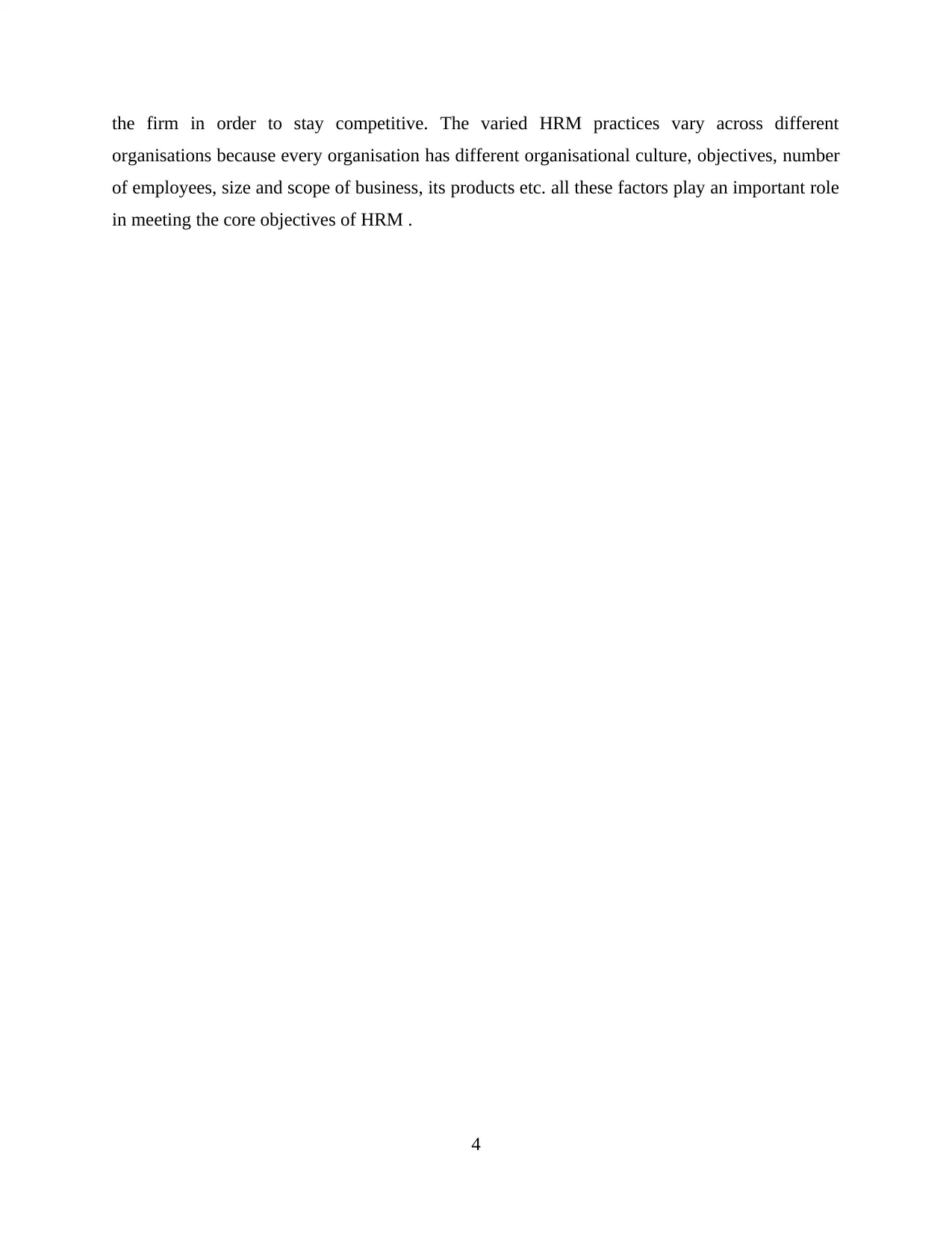
the firm in order to stay competitive. The varied HRM practices vary across different
organisations because every organisation has different organisational culture, objectives, number
of employees, size and scope of business, its products etc. all these factors play an important role
in meeting the core objectives of HRM .
4
organisations because every organisation has different organisational culture, objectives, number
of employees, size and scope of business, its products etc. all these factors play an important role
in meeting the core objectives of HRM .
4
⊘ This is a preview!⊘
Do you want full access?
Subscribe today to unlock all pages.

Trusted by 1+ million students worldwide
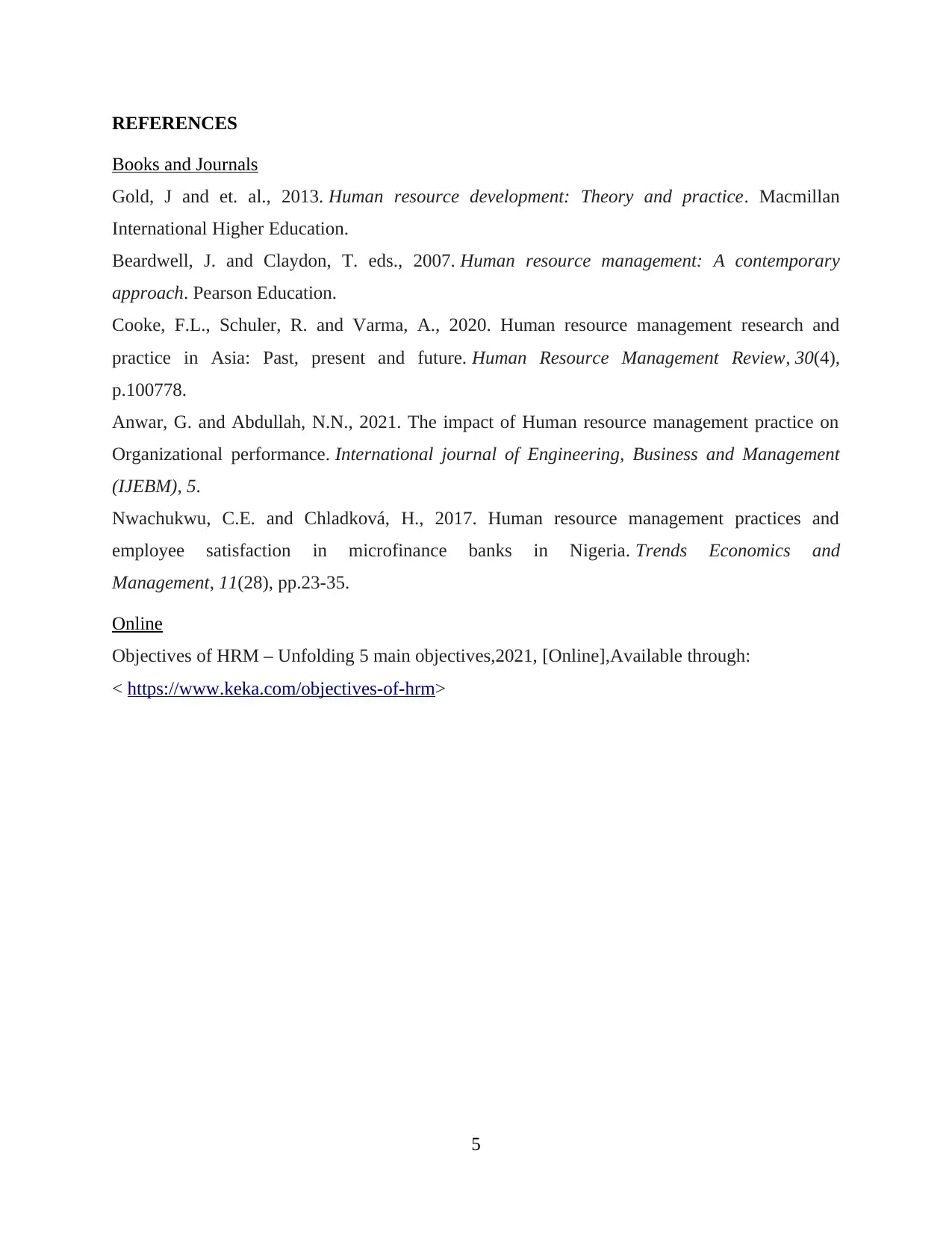
REFERENCES
Books and Journals
Gold, J and et. al., 2013. Human resource development: Theory and practice. Macmillan
International Higher Education.
Beardwell, J. and Claydon, T. eds., 2007. Human resource management: A contemporary
approach. Pearson Education.
Cooke, F.L., Schuler, R. and Varma, A., 2020. Human resource management research and
practice in Asia: Past, present and future. Human Resource Management Review, 30(4),
p.100778.
Anwar, G. and Abdullah, N.N., 2021. The impact of Human resource management practice on
Organizational performance. International journal of Engineering, Business and Management
(IJEBM), 5.
Nwachukwu, C.E. and Chladková, H., 2017. Human resource management practices and
employee satisfaction in microfinance banks in Nigeria. Trends Economics and
Management, 11(28), pp.23-35.
Online
Objectives of HRM – Unfolding 5 main objectives,2021, [Online],Available through:
< https://www.keka.com/objectives-of-hrm>
5
Books and Journals
Gold, J and et. al., 2013. Human resource development: Theory and practice. Macmillan
International Higher Education.
Beardwell, J. and Claydon, T. eds., 2007. Human resource management: A contemporary
approach. Pearson Education.
Cooke, F.L., Schuler, R. and Varma, A., 2020. Human resource management research and
practice in Asia: Past, present and future. Human Resource Management Review, 30(4),
p.100778.
Anwar, G. and Abdullah, N.N., 2021. The impact of Human resource management practice on
Organizational performance. International journal of Engineering, Business and Management
(IJEBM), 5.
Nwachukwu, C.E. and Chladková, H., 2017. Human resource management practices and
employee satisfaction in microfinance banks in Nigeria. Trends Economics and
Management, 11(28), pp.23-35.
Online
Objectives of HRM – Unfolding 5 main objectives,2021, [Online],Available through:
< https://www.keka.com/objectives-of-hrm>
5
1 out of 7
Related Documents
Your All-in-One AI-Powered Toolkit for Academic Success.
+13062052269
info@desklib.com
Available 24*7 on WhatsApp / Email
![[object Object]](/_next/static/media/star-bottom.7253800d.svg)
Unlock your academic potential
Copyright © 2020–2025 A2Z Services. All Rights Reserved. Developed and managed by ZUCOL.



